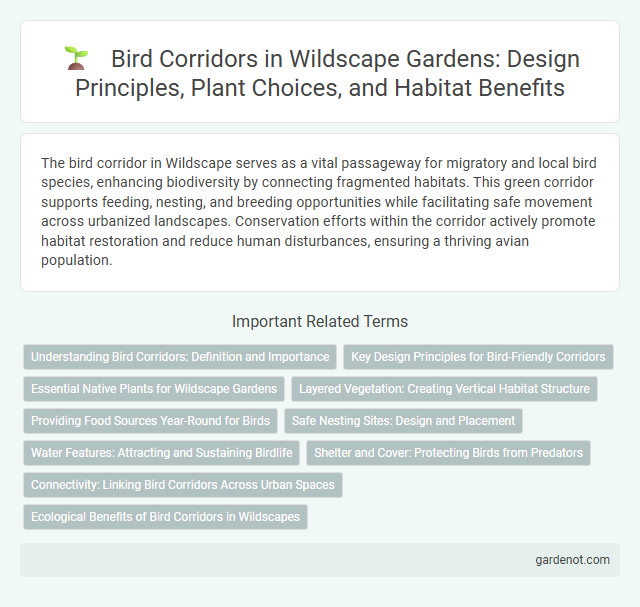The bird corridor in Wildscape serves as a vital passageway for migratory and local bird species, enhancing biodiversity by connecting fragmented habitats. This green corridor supports feeding, nesting, and breeding opportunities while facilitating safe movement across urbanized landscapes. Conservation efforts within the corridor actively promote habitat restoration and reduce human disturbances, ensuring a thriving avian population.
Understanding Bird Corridors: Definition and Importance
Bird corridors are natural or constructed pathways that facilitate safe movement and habitat connectivity for migratory and resident bird species, crucial for maintaining biodiversity and ecosystem health. These corridors reduce habitat fragmentation by linking isolated habitats, allowing birds to access food, breeding sites, and stopover points during migration. Understanding bird corridors helps in designing conservation strategies that support avian populations and promote sustainable wildscape environments.
Key Design Principles for Bird-Friendly Corridors
Key design principles for bird-friendly corridors emphasize maintaining native vegetation to provide natural foraging and nesting habitats, ensuring corridor width supports safe passage and reduces edge effects, and minimizing artificial light and noise pollution to prevent disturbance. Incorporating diverse plant species that attract various bird types enhances biodiversity and corridor functionality. Connectivity between fragmented habitats facilitates genetic exchange and migration, promoting sustainable bird populations in urban and wild landscapes.
Essential Native Plants for Wildscape Gardens
Essential native plants for wildscape bird corridors include milkweed (Asclepias spp.), coneflowers (Echinacea spp.), and goldenrod (Solidago spp.), which provide critical nectar sources and habitat for pollinators and birds. Native grasses such as switchgrass (Panicum virgatum) and little bluestem (Schizachyrium scoparium) enhance shelter and nesting opportunities, supporting diverse avian species. Integrating these native plants optimizes food availability, breeding habitat, and migratory stopover resources within wildscape gardens.
Layered Vegetation: Creating Vertical Habitat Structure
Layered vegetation in bird corridors enhances vertical habitat structure by providing diverse niches for various bird species, promoting biodiversity and supporting complex ecosystems. Taller trees, mid-story shrubs, and ground cover collectively offer shelter, nesting sites, and foraging opportunities, optimizing habitat suitability for both canopy and understory birds. Incorporating native plants that accommodate different vertical layers ensures a resilient corridor that sustains bird populations throughout seasonal changes.
Providing Food Sources Year-Round for Birds
Wildscape's bird corridors ensure consistent food availability by incorporating diverse native plants that bloom and fruit across seasons, supporting migratory and resident bird species. Strategic planting of berries, seeds, and nectar-producing flora promotes nutritional variety essential for bird health and reproduction. This continuous food supply fosters biodiversity and strengthens ecological resilience within the habitat.
Safe Nesting Sites: Design and Placement
Safe nesting sites in wildscape bird corridors are strategically designed using natural materials like dense shrubs and tree cavities to mimic birds' preferred habitats. Placement prioritizes areas protected from predators and human disturbances, ensuring optimal shelter and breeding success. Incorporating elevated platforms and varied vegetation layers enhances nesting security and supports diverse avian species populations.
Water Features: Attracting and Sustaining Birdlife
Water features in bird corridors play a crucial role in attracting and sustaining diverse birdlife by providing essential hydration, bathing spots, and feeding opportunities. Natural ponds, streams, and constructed wetlands support insect populations and aquatic plants that serve as food sources for species such as kingfishers, herons, and warblers. Maintaining clean, well-vegetated water bodies enhances habitat quality and promotes year-round bird activity within the Wildscape ecosystem.
Shelter and Cover: Protecting Birds from Predators
Bird corridors provide essential shelter and cover that protect birds from predators by offering dense vegetation and natural hiding spots. These safe havens reduce predation risk and enhance bird survival rates by creating continuous, secure pathways through varied landscapes. Effective shelter within bird corridors supports biodiversity and fosters healthy bird populations in Wildscape habitats.
Connectivity: Linking Bird Corridors Across Urban Spaces
Bird corridors enhance urban biodiversity by creating continuous green pathways that facilitate safe movement and feeding of avian species across fragmented habitats. Connectivity in these corridors supports migratory routes and genetic diversity, promoting resilient bird populations within cities. Effective linkage of green spaces through native vegetation and minimized human disturbance strengthens ecosystem services and urban wildlife conservation.
Ecological Benefits of Bird Corridors in Wildscapes
Bird corridors in wildscapes enhance biodiversity by providing safe pathways for avian species to migrate, forage, and breed, ensuring genetic diversity and population stability. These corridors support ecosystem services such as pest control, pollination, and seed dispersal, which contribute to habitat restoration and resilience. Maintaining continuous habitats through bird corridors mitigates the effects of habitat fragmentation, promoting ecological balance and climate adaptation.
Bird corridor Infographic

 gardenot.com
gardenot.com